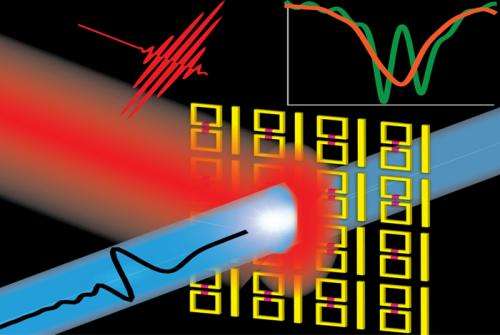Metamaterials provide active control of 'slow light' devices

LANL researchers and collaborators have made the first demonstration of rapidly switching on and off "slow light" in specially designed metamaterials at room temperature. Metamaterials are assemblies of multiple individual elements fashioned from conventional microscopic materials arranged in periodic patterns. This work opens the possibility to design novel chip-scale, ultrafast devices for applications in terahertz wireless communications and all-optical computing.
Significance of the research
In slow light, a propagating light pulse is substantially slowed down (compared with the velocity of light in a vacuum). This is accomplished by the interaction with the medium in which the propagation takes place. Slow light has potential applications in telecommunications because it could lead to a more orderly traffic flow in networks. Like cars slowing down or speeding up to negotiate an intersection, packets of information can be better managed if their transmission speed is changeable.
Another potential application is the storage of information carried by light pulses, leading to a potential all-optical computing system. Current semiconductor materials used in computing devices are reaching some of their limits, and an all-optical system would potentially enable improvements in size reduction and calculation speeds. The effects of strong light-matter coupling used in slowing down light might be used to create entangled photon pairs, leading to quantum computing capabilities beyond the capabilities of modern computers.
Research achievements
Electromagnetically induced transparency is a quantum interference effect that produces a sharp resonance with extremely low loss and dispersion. However, implementing electromagnetically induced transparency in chip-scale applications is difficult due to the demands of stable gas lasers and low-temperature environments. Metamaterials are engineered artificial materials containing structures that are smaller than the wavelength of the waves they affect. Metamaterial analogues of electromagnetically induced transparency phenomena enable a unique route to endow classical optical structures with aspects of quantum optical systems.
The researchers integrated photoconductive silicon into the metamaterial unit cell. This material enables a switching of the transparency resonance window through the excitation of ultrafast femtosecond optical pulses. This phenomenon causes an optically tunable group delay of the terahertz light. The "slow light" behavior can be controlled at an ultrafast time scale by integrating appropriate semiconductor materials with conventional metamaterial designs.
In this research, the medium is an active metamaterial that supports a sharp resonance, which leads to a rapid change in the refractive index of the medium over a small range of frequencies. This phenomenon causes a dramatic reduction in the velocity of terahertz light propagation. The resonance can be switched on and off on a time scale of a few pico-seconds (a pico-second is 10-12 second). When the resonance transparency is on, the system produces slow light. When the resonance is off, the slow light behavior disappears. This on and off process happens on an ultrafast (pico-second) time scale when a femto-second (10-15 second) laser pulse excites the metamaterial.
Nature Communications published the research.
Journal information: Nature Communications
Provided by Los Alamos National Laboratory


















